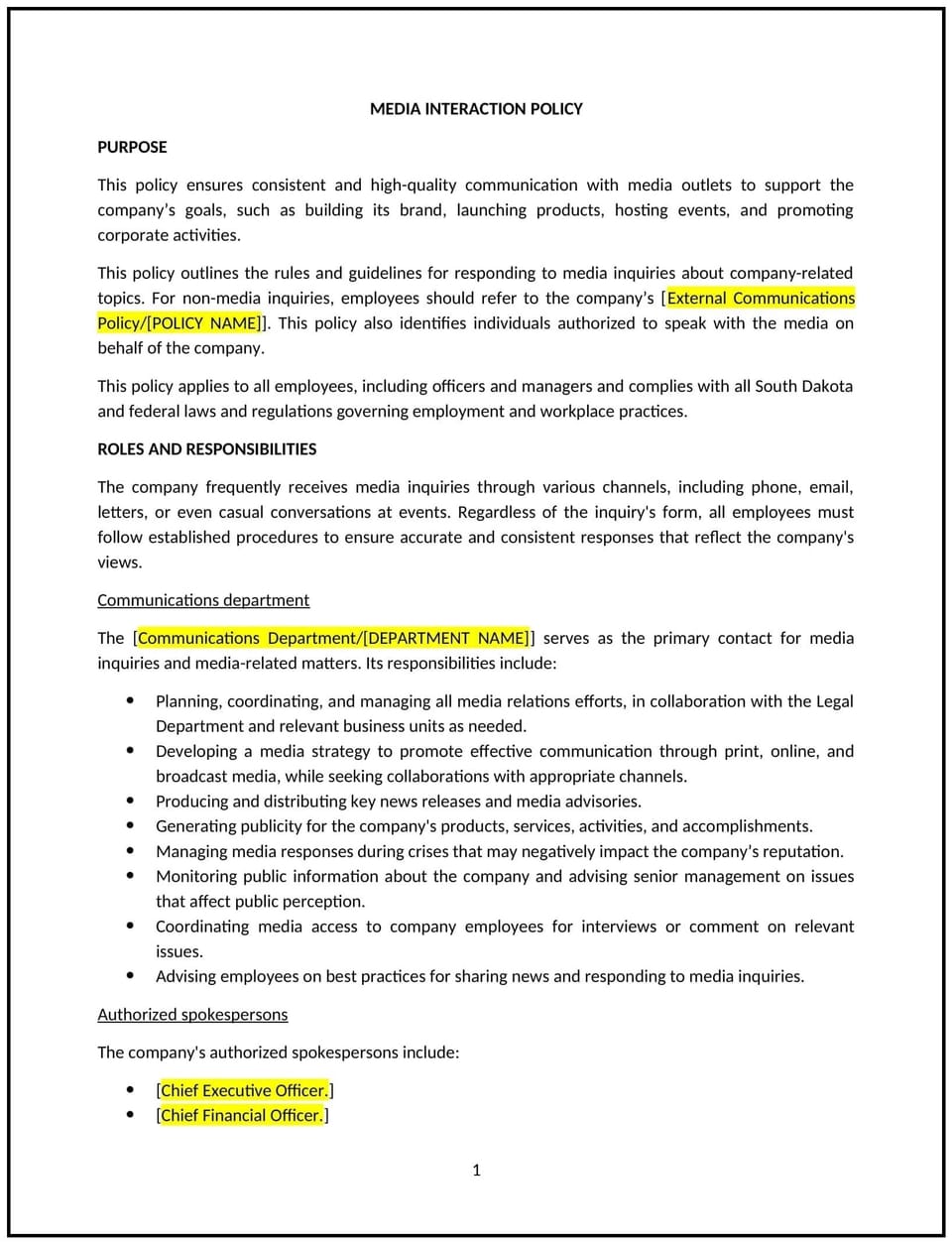Media relations policy (South Dakota): Free template

Media relations policy (South Dakota)
This media relations policy is designed to help South Dakota businesses establish guidelines for interacting with the media. It outlines procedures for responding to inquiries, issuing press releases, and managing public statements.
By adopting this policy, businesses can protect their reputation, ensure consistent messaging, and align with general best practices for media engagement.
How to use this media relations policy (South Dakota)
- Define media interactions: Explain what constitutes media interactions, such as interviews, press releases, or social media posts.
- Establish approval processes: Specify who is authorized to speak on behalf of the business and the steps for approving media statements.
- Set tone and style guidelines: Provide examples of the preferred tone, language, and branding for media communications.
- Address crisis communication: Outline procedures for handling sensitive or urgent media inquiries, such as during a public relations issue.
- Train employees: Educate staff on the policy and their responsibilities when interacting with the media.
- Monitor compliance: Regularly review media interactions to ensure adherence to the policy.
- Review and update: Assess the policy annually to ensure it aligns with evolving business needs and media trends.
Benefits of using this media relations policy (South Dakota)
This policy offers several advantages for South Dakota businesses:
- Protects reputation: Ensures consistent and professional messaging to the media, reducing the risk of miscommunication.
- Enhances credibility: Demonstrates a commitment to transparency and accountability in media interactions.
- Supports crisis management: Provides clear guidelines for handling sensitive or urgent media inquiries.
- Builds trust: Strengthens relationships with the media and the public by fostering transparent communication.
- Supports compliance: Aligns with best practices for media engagement and public relations.
Tips for using this media relations policy (South Dakota)
- Communicate the policy: Share the policy with employees and include it in training materials.
- Provide training: Educate staff on the importance of consistent and professional media interactions.
- Monitor compliance: Regularly review media interactions to ensure adherence to the policy.
- Address issues promptly: Take corrective action if media interactions violate the policy or harm the business’s reputation.
- Update regularly: Assess the policy annually to ensure it aligns with evolving media trends and business needs.
Q: How does this policy benefit businesses?
A: By establishing clear guidelines for media interactions, businesses can protect their reputation, enhance credibility, and support crisis management.
Q: Who is responsible for approving media statements?
A: Typically, designated managers or communications teams are responsible for approving media statements, depending on the business’s structure.
Q: What should businesses do if a media error occurs?
A: Businesses should address the issue promptly, issue corrections if necessary, and review their processes to prevent future errors.
Q: Can employees use personal social media to represent the business?
A: Employees should avoid representing the business on personal social media unless explicitly authorized by the policy.
Q: How often should businesses review this policy?
A: Businesses should review the policy annually or as needed to ensure it aligns with evolving media trends.
This article contains general legal information and does not contain legal advice. Cobrief is not a law firm or a substitute for an attorney or law firm. The law is complex and changes often. For legal advice, please ask a lawyer.


